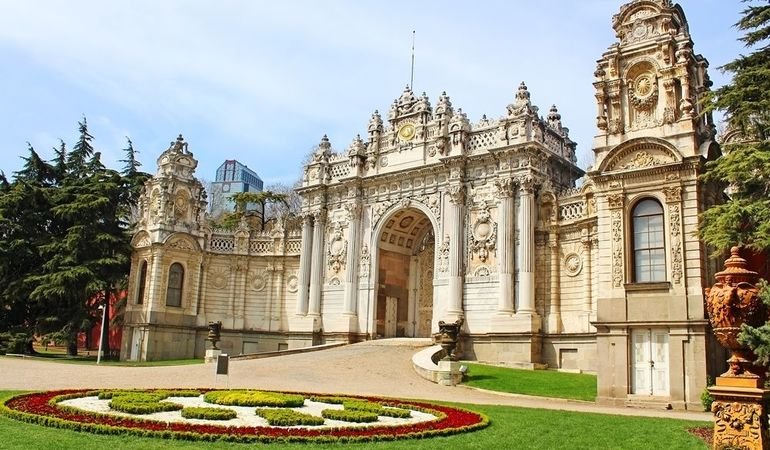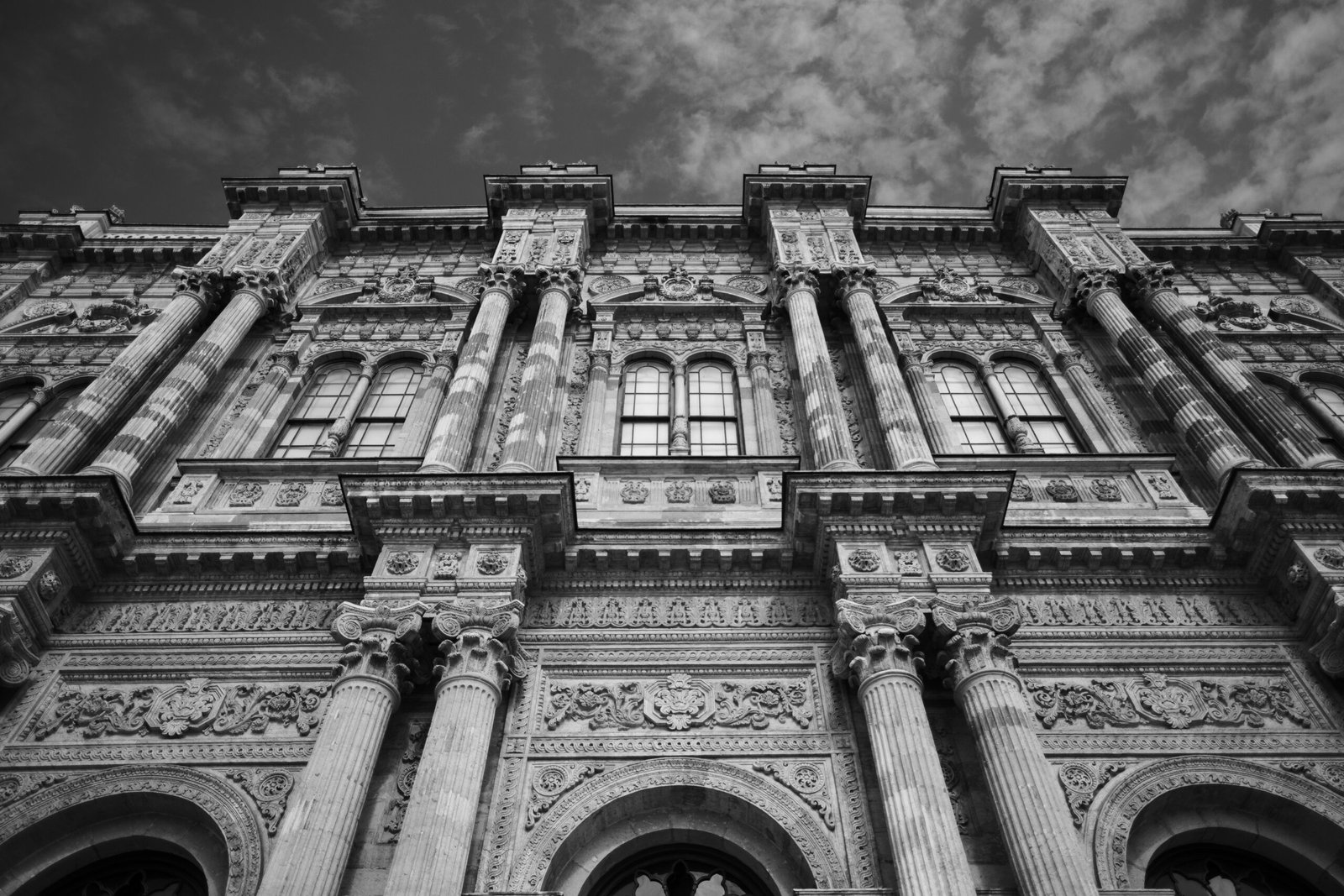Dolmabahçe Palace
- History and Culture
- Posted 1 year ago
- Go Back
Introduction to Dolmabahçe Palace
Dolmabahçe Palace stands resplendent on the European coast of the Bosphorus Strait in Istanbul, Turkey. A manifestation of Ottoman opulence, the palace was constructed in the mid-19th century under Sultan Abdulmejid I during the waning years of the empire. Noteworthy for its historical significance, Dolmabahçe Palace served as the administrative center of the Ottoman Empire and later as the official residence of its last six sultans. Its relevance extended into the early Republic era, converting into a central symbol of both Ottoman and modern Turkish history.
The architectural grandeur of Dolmabahçe Palace distinctly showcases an amalgamation of Baroque, Rococo, and Neoclassical styles. The design was collaboratively executed by the renowned Armenian-Turkish architects Garabet Balyan, of the eminent Balyan family, and his son, Nigoğayos Balyan. Their inspiration drew heavily from European architectural elements, reflecting a period of westernization and modernization within the empire. The palace occupies an expansive 45,000 square meters and contains approximately 285 rooms, 46 halls, six baths (hamams), and sixty-eight toilets.
Dolmabahçe Palace’s interior is a testament to luxury and artistic finesse. The ceremonial hall, outfitted with one of the world’s largest Bohemian crystal chandeliers, epitomizes the opulence of the Ottoman era. Intricate designs, ornate ceilings, and lavishly decorated rooms all contribute to the overall magnificence of the palace. Visitors can observe the blend of precious gemstones, glistening gold, and the finest materials sourced from across the globe, embodying the empire’s vast reach and wealth.
The historical and architectural significance of Dolmabahçe Palace resonates not only in Turkey but globally. It reflects a pivotal moment in Turkish history, bridging the gap between Ottoman grandeur and the birth of the modern Republic. The palace continues to attract numerous visitors, providing a window into the lavish lifestyle of the Ottoman royalty and the rich tapestry of Turkish heritage.

Architectural Marvels and Interior Design
Dolmabahçe Palace stands as a testament to the opulent lifestyle and discerning taste of the Ottoman sultans. The palace’s architecture seamlessly blends traditional Ottoman elements with European neoclassical styles, creating a visually stunning masterpiece. One of the most awe-inspiring spaces within the palace is the Ceremonial Hall, also known as the Muayede Hall. This hall, spanning a colossal 2,000 square meters, is accentuated by a soaring dome and a dazzling array of crystal chandeliers, including one particularly massive piece gifted by Queen Victoria. The sheer splendor of this room is a perfect encapsulation of the grandeur inherent in Dolmabahçe Palace.
The intricate detailing in every corner of the palace does not go unnoticed. An exemplary highlight is the Crystal Staircase, which is composed of Baccarat crystal, brass, and mahogany. This staircase is not merely functional but an exquisite piece of art, catching and reflecting light in all its facets. Another notable feature is the room known as the Sultan’s bedroom. This space epitomizes luxury and comfort, adorned with plush furnishings, elaborate gold trimmings, and rich marble textures. The use of gold is pervasive yet tasteful, integrating seamlessly with the architectural elements to create a warm, majestic ambiance.

Additionally, the interior of Dolmabahçe Palace is replete with stunning marble work, especially evident in the Hall of Mirrors. The use of Egyptian alabaster and Carrara marble showcases the exquisite craftsmanship and the lengths to which the designers went to ensure every inch of the palace radiated magnificence. Noteworthy rooms such as the Medhal Hall further illustrate the splendor, with their rich tapestries, inlaid woodwork, and masterfully painted ceilings. Each room intricately contributes to the overarching narrative of wealth, power, and artistic prowess that is the hallmark of Dolmabahçe Palace.
Historical Significance and Key Events
Dolmabahçe Palace stands as a monumental testimony to the grandeur and historical depth of the Ottoman Empire and the Turkish Republic. Consciously constructed to surpass the splendor of European palaces, it served as the empire’s main administrative hub from 1856 until the abolition of the caliphate in 1924. This architectural masterpiece was more than a royal residence; it was a pivotal locale for numerous historic events that shaped modern Turkey.
Among the many significant events, the signing of vital treaties stands out. The palace hosted the agreement of several agreements that had far-reaching consequences for the empire’s fate. These treaties, often held in the lavishly adorned halls, signaled shifts in power, territorial adjustments, and international relations pivotal to the region’s history.
Furthermore, Dolmabahçe was the reception site for a multitude of foreign dignitaries. Its ornate rooms and halls played witness to the reception of emperors, kings, and statesmen, reinforcing its role as a key diplomatic stage. These high-profile visits underscored the empire’s prestige and its efforts to forge and maintain crucial alliances during a time of significant geopolitical changes.
The palace also occupies an important place in the early years of the Turkish Republic. After the fall of the Ottoman Empire, it continued to be a central venue for state functions. Most notably, it was the place where Mustafa Kemal Atatürk, the founder of modern Turkey, spent his final days. Atatürk’s death in Dolmabahçe on November 10, 1938, marked a poignant chapter in the nation’s history. His passing in this revered setting underscored the palace’s continued relevance, bridging the historic imperium and the nascent republic.
Each of these events imbued Dolmabahçe Palace with a layer of historical significance, cementing its status as a cultural and political beacon. The palace not only reflects the opulent lifestyle of the Ottoman sultans but also encapsulates the pivotal moments that shaped the modern Turkish state.

Visiting Dolmabahçe Palace Today
Dolmabahçe Palace, an iconic landmark in Istanbul, offers an unforgettable experience for visitors. Its majestic architecture and historical significance draw tourists from around the globe. If you plan to explore this magnificent palace, there are several practical aspects to consider for a well-rounded visit.
The palace is open to the public every day except Mondays. Operating hours are generally from 9:00 AM to 4:00 PM, but it is advisable to check the official website for any changes or seasonal adjustments. Tickets can be purchased at the entrance or online to avoid long queues, especially during peak tourist seasons. The standard ticket price varies, with discounted rates available for students, children, and seniors.
Guided tours are highly recommended as they provide in-depth insights into the palace’s rich history and opulent rooms. These tours are available in multiple languages and can be booked in advance. Self-guided audio tours are also a great option for those who prefer exploring at their own pace.
To make the most of your visit, it is best to arrive early in the morning or late in the afternoon to avoid the crowds. Weekdays are generally less busy than weekends. Also, spending some time exploring the nearby attractions, such as the Bosphorus Strait and the historic Beşiktaş district, can enrich your overall experience.
The visitor experience at Dolmabahçe Palace is both educational and awe-inspiring. From the intricate designs of the crystal chandeliers to the grandeur of the ceremonial halls, every aspect of the palace showcases the splendor of the Ottoman Empire. Comfortable walking shoes are recommended as the tour involves substantial walking.
For a comprehensive and enjoyable visit, make sure to plan ahead, take advantage of guided tours, and allow yourself ample time to absorb the beauty and history of Dolmabahçe Palace. This iconic landmark promises an enriching journey through time and culture.
Get a free quote
Nearby Hospitals
No results available

